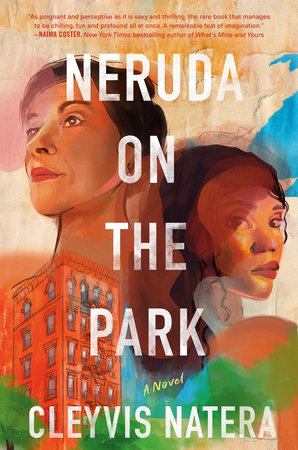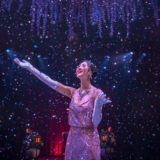Neruda On The Park Author Interview By: Rose Heredia


This past March, I had the opportunity to meet a first-time published Afro-Dominican author at AWP in Philadelphia. I saw her name, noticed it on panels, and printed it in different publications. Her name is Cleyvis Natera, and her first novel, Neruda on the Park, was published this week. When I saw the cover and the name of the story, I knew I had not only to meet her but have the opportunity to read her book before anyone else! It was perfect because then I was able to interview Cleyvis about her novel and writing process.
Rose Heredia: I read somewhere that you started writing stories at ten years old. What was it about writing that has held you in your grips since then? And also, if you remember, what was your first story about when you wrote it at ten years old?
Cleyvis Natera: Perhaps you read that I became a storyteller at ten? When I traveled to the US with my siblings and mother, I was ten years old. I was separated from my father. At the time, my father was my whole world. He chose not to travel to the United States. And when I arrived in the United States, my mother had to work 24 hours a day to take care of four children on her own. So strangely, we didn’t gain a parent by coming here; we lost both parents.
For much of the first year after arriving here, the only way I talked to my dad was if we went to a calling center since my Abuelita’s house didn’t have long-distance calling, and we couldn’t talk for very long because the calls charged by the minute. That’s where the first seed of my becoming a writer began because it was the first time I thought about words as meaningful. Telling stories connected me to my father; I was cautious about what I needed to say and how to say it. I became aware of how powerful words are in connecting us to each other across the vastness of space. I can trace the origin of myself as a storyteller to that loss. But I first began as an oral storyteller, which is my cultural legacy, and not as a writer – I would come to write fiction in college.
RH: Were there any plotlines you had to leave on the cutting floor or hanging out in a leftover document? Because I feel this world was so vast and rich, it could have gone on for pages long. I wanted more interaction with Angelica and the other people in this novel. What darlings did you “kill” in this book to arrive at the book that was published?
CN: I always knew Neruda on the Park was about a mother and daughter who take starkly different approaches when the threat of losing their home to gentrification arrives in their neighborhood. Through so many revisions over the years, the most significant sacrifice was to POV – which means rewriting meant starting over again so the entire last draft would be on the cutting floor! Ofrézcome, did those changes hurt! This book started as a first-person POV from Luz Guerrero, who is the daughter. Then it changed over to a first plural with the Tongues acting as the “we” chorus, interspersed with each person Eusebia convinces to be part of her crime ring. But each of those attempts failed because the story, at its heart, is about this mother-daughter duo, and the final resting place, with the two as the anchors of perception, ended up being the best and final form.
RH: As a debut author, whose career have you admired the most? Or wish to be the next – Like, I want to be like Toni Morrison, James Baldwin, etc. What has this been like for you?
CN: It’s probably due to my age or maybe since it was challenging to arrive at this moment as a debut author that I don’t think it’s possible to replicate the success of my most admired writers – those include Julia Alvarez, Toni Morrison, Gabriel Garcia Marquez, Arundhati Roy, to name a few. But I’d like to work in their legacy, which means crafting books that tell the truth, that reflect and archive the parts of our lived experience often left out of history books and the mainstream media. Most of all, it’s a celebration of our community pursuing lives full of pain and loss, yes, but also pleasure and joy.
RH: What are your favorite, if you have any, mother/daughter relationship stories in the media? Like a TV show, book, or film that has resonated with you? And if so, did any of these stories inspire some aspects of your novel?
CN: Naima Coster is one of the most brilliant writers writing about mother-daughter dynamics. Halsey Street, her debut, is still one of my favorite books. It deals with this topic with honesty and so much beauty. Her sophomore novel, What’s Mine and Yours, also tackles this subject with remarkable skill. I suggest that anyone who hasn’t read Naima’s work to pick it up immediately. You’ll thank me!
RH: I’m pre-empting this question because I don’t want to include spoilers from this book. Was there any time when a specific character wouldn’t make it until the end? Was that ever possible, or was that my anxiety kicking in during the third act?
CN: You’re so good at preempting I don’t even know what you’re talking about! Ha. The idea of what Eusebia, the mother character, is willing to do to protect this neighborhood and how her plans spiral out of control was a critical element I wanted to explore. I’m interested in interrogating how grief and loss turn some people into monsters. And so, an idea rooted in love and protection to ensure survival is what creates the risk of death was very much the intention.
RH: I enjoyed how the lyricism in your novel had me slowing down to savor every moment depicted on the page. Obviously, you are a fan of Pablo Neruda. What other poets do you read? Have you written poetry? And if so, would you publish a chapbook in the future?
CN: I’m not a writer of poetry, but I absolutely love poems and poets. Among my favorite poets is Natalie Diaz, whose last book, Postcolonial Love Poem, winner of the Pulitzer in 2021, is one of the most beautiful, sexy, and haunting collections of poems I’ve read. Diaz’s poetry makes songs out of longing for home, romantic and familial love. She never shies away from confronting the systems and structures invested in our dehumanization.
RH: It took you 15 years to write this book. What was it about this story that kept you coming back to the page?
CN: Over the fifteen years that I wrote this book, I witnessed a great deal of change in my hometown of New York City. Gentrification is a reality that most of us have lived through, and I remember the brutality that forced people in Latine and Black neighborhoods out of their homes. It was important to me to push against the narrative that says gentrification is good for communities. The term revitalization – coined to explain the process of gentrifying our neighborhoods – means to imbue something with new life and vitality. Our neighborhoods aren’t dead — vitality courses through our blood. There is evident neglect in what some consider our communities. Still even that, I would argue, often lies in the hands of governmental bodies that feel a lack of responsibility for injecting care by way of resources into our communities. Some of that has changed but not enough. Therefore, it was critical that I write a story full of life, humor, and love to show we live full lives and showcase the horror of what it means to live in fear of losing your home. I wanted to get that right, and Neruda on the Park required that I grow up and live a lot before I could get it right.
RH: Sometimes stories take a long time to write. And we grow and live a little, and those stories grow and evolve with us. How did you change as human writing this story? How did it affect you?
CN: This is the question that could fill up an entire book! Thank you for asking it. As I mentioned a moment ago, I believe that it took so long to write this book because I had to live and learn specific lessons to get the book right. One of the most significant changes in my life is that I became a mother while writing this book. During certain moments of my life as a new mother, I remember thinking that I would do anything for my children. I mean, crazy-insane, anything required to make sure my kids are safe. Another key revelation that happened to me as a result of motherhood is that when my son was three to four years old, he underwent two bone marrow transplants, and during the second one, we almost lost him. Until then, I didn’t understand the despair that lives even at the risk of enormous loss. I had never experienced such a plunge. Learning that was a critical element of what is required to pull off the complex plot of this book and still have it be a story about the love between families, lovers, friends, and communities.
RH: What was your favorite part about writing for Luz and Eusebia on the page? And the least favorite part?
CN: These two women love each other fiercely, so it was so wonderful to write about their bond. I don’t know that I have a least favorite part but what was challenging to note was how the relationship fractures due to silences and secrets.
RH: What book are you reading right now? And if you aren’t reading anything right now, what was the last book or books that kept living rent-free in your head?
CN: I love Christine Kandic Torres’ The Girls in Queens. It’s a story about friendship told in two different timelines. Brisma and Kelly are young women and best friends growing up in Queens and must learn some difficult lessons in this coming-of-age story about toxic masculinity. To come of age, they must learn how to navigate a world that is very often hostile to them. I also love the way Torres holds a mirror up to how members of our communities can be complicit in upholding structures meant to dehumanize them – a theme I’m obsessed with! This debut announces Torres as a powerful and insightful novelist. I can’t wait to see what this novel will do in the world once it comes out on June 14th!
Neruda on the Park is available to purchase anywhere books are sold.




Comments
Trackbacks & Pingbacks
[…] poem is a story in verse that speaks to generational curses, coming of age, fleeting loves and lasting […]